Voicing
Closed vs. Open
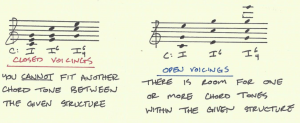

Spacing
Keep adjacent upper voice pairs within one octave of one another (S+A, A+T).
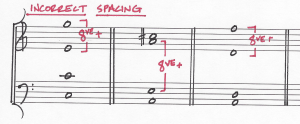

Greater distance is required between the tenor and bass voice. Closed voicings between the lower voices often creates dissonances in overtones, which results in a muddier sound.
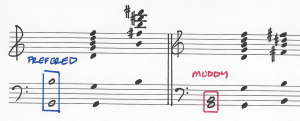

Doubling
Doubling is often necessary in a four-part texture, especially in part-writing with triads. There are three general guidelines:
- Do not double sensitive tones (leading tone, altered tones, sevenths).
- In major and minor triads, it is usually preferable to double the bass note (especially in root position and second inversion).
- In diminished and augmented triads, voice the chord in first inversion and double the bass note (the third of the chord).
These rules boil down to a Cliff Notes version of doubling:
Double the bass note unless it’s a sensitive note in the chord.
Additional Considerations
Sometimes melodic situations will force other doublings. If you stray from the guidelines above, keep in mind that it is better to double the melodically stable notes in a key (1, 4, 5) than the notes with a tendency to move (2, 3, 6).
In other situations, correct melodic resolutions may cause you to omit a chord member. The 5th of a chord is the first choice to omit.
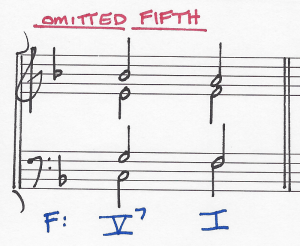

Connecting Chords
Reminder: these guidelines apply to the period of Common Practice. Much of the music that has come since purposefully creates its own set of rules. It is important to understand what came first to understand what came later.
Voice Leading is the process of constructing melodies in a harmonic context in such a way that they are they are:
- Singable
- Pleasing to the ear
- Harmonically effective
Continue to consult melodic principles as you write in four-part texture.
Consecutive Perfect Fifths and Octaves
When two voices move in parallel motion from a P5 or P8, the independence of voice is compromised. This effect also occurs when the intervals are compounded (additional octave), even if they move in contrary motion. Avoid writing parallel perfect fifths and octaves.
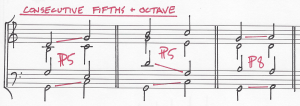

Voice Crossing/Overlap
When one voice in a structure is placed out of sequence with the other voices, it obscures the melodic intent. This can be difficult to spot, particularly in the alto and tenor voices, since their range of movement is so limited.
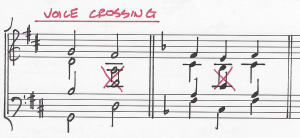

This is not a forbidden technique, but should be used very sparingly so that all melodies have integrity.
Common Tones
When possible, retain common tones between chords that share them. This will result in the smoothest voice leading.
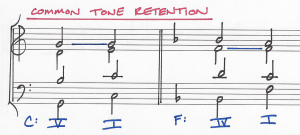

When common tones do not exist between chords, move the upper voices in contrary motion to the bass voice to avoid consecutive P5.
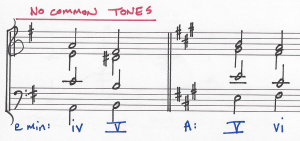


Leave a Reply